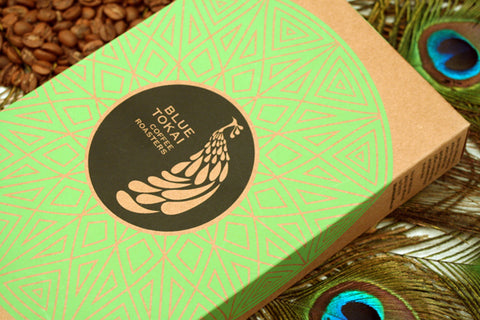When I tell my family and friends where I work, I expect questions about roasting and what a roasterie is, but what I tend to hear a lot is: “What’s ‘tokai’?” “Is it an English word?” “Did your boss make it up?” In other words, they’re as intrigued and confused by the name as I was.
One of the FAQs on the website answered some of my questions but I was still curious as to why Namrata and Matt picked this strange sounding word.
To try and understand more about the origins of the brand name, I traced the path of Blue Tokai Coffee Roasters when it was just a glimpse of an idea. Before Matt and Namrata moved to Delhi, they lived in Chennai with easy access to tiny kiosks where coffee drinkers can get their coffees blended and ground. They also had the ability to interact with local roasters. Frustrated with and slightly confused by the lack of freshly roasted coffee in North India, they decided to indulge their entrepreneurial spirit (and put Matt’s prior roasting experience to use) by starting a coffee roasterie of their own. Their goal was to highlight Indian coffee by getting it directly from the farm and delivering it to their customers instead of their customers having to import Indian coffee that had been roasted abroad.
Fast forward to a month later, and a unique looking bird (identified as a Great Caucal after an intense google search) decided to build a nest on a balcony facing Namrata’s desk while she was thinking up ideas for a logo. Namrata had created a peacock design in the past and thought that it made sense for the country’s national bird to be associated with the name of a business that wanted to highlight some of India’s best coffee. .
Yet another Google search session led to the word ‘tokai’. In ancient Malabari, ‘tokai’ meant the plume of the peacock. Not only does the bird represent India, but it also reminded Namrata of numerous peacock sightings during her childhood summer visits to the country and the choice just felt right.
Coincidentally, the Malabar region was not only where the peacock was seen by the British for the first time (the locals had, of course seen it a million times before that) but the British are important to the coffee connection since they created systematic cultivations and introduced Indian coffee farms to the world by initiating exports.
Tying in the peacock and the coffee plantations, ‘tokai’ became a symbol for Indian coffee estates and traceable Indian coffee. There is a sense of pride at the roasterie when local coffee is highlighted - and a connection between the farms and customers is created.

To stress on the peacock’s tokai even more, we are changing our logo from colored stickers to a vividly colored plume to distinguish between the different blends. The farm related images by local artists on the coffee packets also highlight the beauty and diversity of India, emphasizing our mission to put Indian coffee farms on the map and bolster the consumption of local coffee.
This blog post was written by Rhea Sanghi, the Community Manager at Blue Tokai, and you can e-mail her at rhea@bluetokaicoffee.com or come by the roasterie to chat in person!





